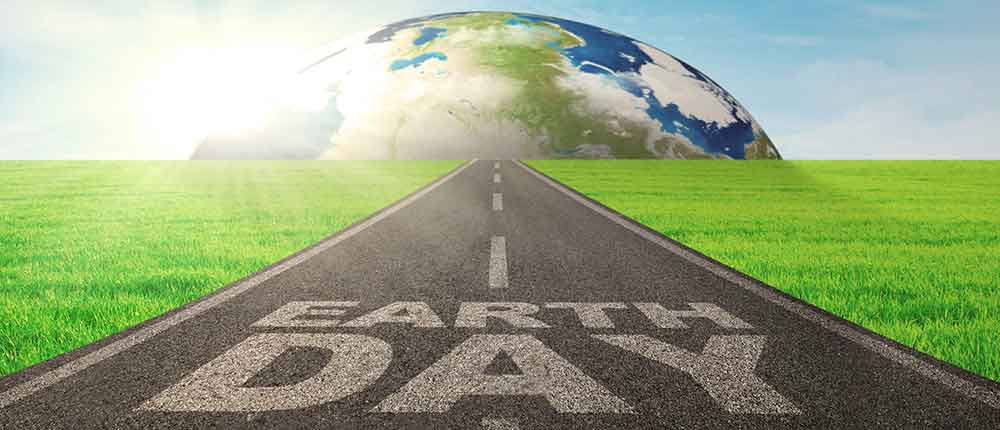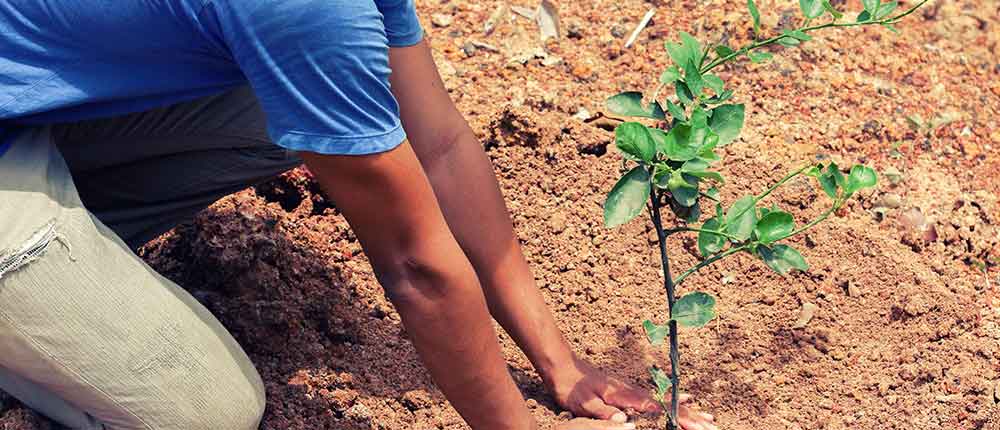Earth Day is an annual event celebrated around the world on April 22 to demonstrate support for environmental protection. In this article, Arpita Dasgupta points out that the COVID-19 pandemic is, in fact, a red flag pointing to an imbalance in our natural systems. It is a sign of a planet in disharmony. So, there is only one way forward—restoring what is lost to bring back a sense of equilibrium. This is the reason why the theme for Earth Day 2021 is 'Restore Our Earth'. She also stresses that environmental and climate literacy is the foundation for an equitable and sustainable society. It is for this reason that the Earth Day Network has pledged to educate 100 lakh youngsters on environmental issues by 2026 through diverse programmes.

Earth 2050: Picture this—the world has faced pandemic after pandemic. 2020 was just the beginning, but little did we know then. Who would have thought a coronavirus will lead to a cycle of devastation that would end most human life on the planet? Now, there are only a few of us left to tell this story. A story that we wish we could have written differently. But, alas. If only we had paused to listen to the telling signs that were all around us. If only we had made a change when there was still time and restored our Earth to its previous glory, we could have given our young generations a chance at a better life. It is now almost 30 years since civilization as we knew it in 2020 has ceased to exist. With humans gone, the Earth has begun to send out new shoots of life, reaching high into a blue sky filled with birds of a thousand kind. The biggest error in judgment that mankind ever made with respect to the Earth was the assumption that the planet needed to be saved. We now know better.
'Does the apocalyptic scenario seem too harsh, too unreal?' The young girl snapped out of her trance on hearing her mother's question. They were considering what the Earth might look like decades from now, if human beings continued living life the same as before. The older woman had been telling her the story of Chernobyl. It was to be a part of the project she was making for Earth Day 2021—a project close to her heart since she had already been witness to a devastating pandemic early in life. They continued the conversation.
The Earth Doesn't Need Us; We Need the Planet
The fact of the matter is that we need the Earth to survive, not the other way around. Without humans and human activity, our planet will regenerate on its own. Most people know of the Chernobyl tragedy when on April 25–26, 1986, a safety test at the Chernobyl Nuclear Plant went horribly wrong, causing what is unanimously accepted to be the world's worst nuclear accident. The fire that erupted raged on for more than a week. It killed more than 31 people instantly. Even today, it is hard to know the exact number of deaths caused by this calamity, but an estimation by the WHO pegs this number at more than 4000.
But what is going on at Chernobyl in the present day? Many are surprised to learn of the unexpected outcome of the catastrophe. Parts of the 30-km exclusion zone at the site have turned into a hotspot for biodiversity. The growing number of bears, lynxes, European bison, boars, and Przewalski's horses are being seen by scientists. Untouched by human activity, the flora and fauna in the region found ways to adapt and thrive. This seems to suggest two things. One, plants and animals are more resilient to radiation than thought previously. A case in point is of the frogs living inside the exclusion zone, which adapted to the high radiation levels by becoming darker than their fellow beings outside the zone. Humans perished, but they survived. The second, and more shocking, revelation is that the natural world may be better off in the face of a catastrophic nuclear disaster than continuing human activity!

No Safe Spaces in the Wake of a Pandemic
It's been 51 long years since Earth Day was first celebrated in the US on April 22, 1970, a time of great social and environmental activism. We have certainly come a long way since then to better understand the planet and its ecosystems. We have signed many international treaties to combat climate change and its many-headed demons; yet, with every challenge that was overcome, human activity seemed to throw another along the way.
The young girl pondered on the irony of it all. In the quest for technological advancements and seemingly better quality of life, our leaders are leaving behind a dirty pile of problems for the younger generation to tackle. If the global COVID-19 pandemic has taught one thing, it is this: everyone is affected by the pandemic, directly or indirectly. According to scientists, zoonotic diseases, such as COVID-19, can be traced to changes in land use and deforestation. We are taking over land that was home to other species in the past. SARS, H1N1, Ebola, MERS, Zika, and Nipah are also all examples of viruses jumping the species barrier. As the apocalyptic vision of 2050 seemed to suggest, such pandemics aren't bizarre manifestations of a small error in judgement. The pandemic of 2020 is, in fact, a red flag pointing to an imbalance in our natural systems. It is a sign of a planet in disharmony. There is only one way forward. Restoring what is lost to bring back a sense of equilibrium. This is the reason why the theme for Earth Day 2021 is 'Restore Our Earth'. It is the only solution to the hydra-headed conundrum we find ourselves in. This theme rejects the idea that the only way to save the planet is to reduce the impacts of climate change or adapt to them. Instead, it takes the lead in building a narrative that restores what is already lost—ecosystems and forests, protecting threatened wildlife species, cleaning the oceans of plastic and other waste, and finally educating the youth to promote and practice green living.
Educate, Innovate, and Be Aware
Of the five ecological movements under the Earth Day 2021 theme, one especially struck a chord with the young girl—that of climate literacy. She knows that it is key to survival of an entire generation because only climate literacy will give them the tools they need to fight ahead. Undoubtedly, their challenges will have no easy solutions; they will be way harder on a planet that will have to accommodate 900 crore humans by 2050!
The need for education, especially environmental literacy, cannot be stressed enough. In the same way that education gives access to decision making and participation in democratic processes, environmental and climate literacy is the foundation for an equitable and sustainable society. It is for this reason that the Earth Day Network (EDN) has pledged to educate 100 lakh youngsters by 2026 through diverse programmes involving NGOs, governments, teachers, and students. Simple initiatives such as encouraging schools to focus on environmental issues during morning assemblies can reach 150,000 children annually. For the creative minded, students are also being given a free hand at painting murals on the walls of their school buildings on themes related to the environment. Taking forward 2020's theme of celebrating Earth Day digitally—necessary at a time when most of the world's population was under lockdown—the Earth Reel competition for 2021 invites students to create short films on environmental issues for greater awareness. This competition will encourage young people across India to find creative ways to spread their message of a restored planet within and beyond national boundaries.
The young girl paused for a moment. Her thoughts were with the 60 lakh children in India who do not go to school. What of them? In countries such as India, poverty might prevent children from going to school. They may be forced into paid or unpaid labour to support their families. Where there are schools, there may be age-old cultural traditions preventing children, especially girls, from going to school. Even in 2021, in many parts of the country, the girl child is given second preference when it comes to education. For these and the 28.7 crore illiterate adults, the climate literacy is a far cry. For them, the struggle to earn a livelihood far outweighs any concern for the Earth, and naturally so.

Green the Planet
The young girl now sat to consider the second movement under the 2021 Earth Day theme. On the face of it, the #Trees4Earth movement seemed simple enough—plant enough trees to make up for the loss of green cover on the planet. But let us first look at what the movement has achieved in the Indian context.
Since the inception of this movement in 2016, over 9000 lakh trees have been planted in India. The plantation drive at one of India's most drought-prone areas merits a mention. This is the story of Lalitpur district in Uttar Pradesh. As part of this programme by EDN, more than 100,000 fruit saplings were distributed in Lalitpur alone. The people of this community were made to understand the benefits of planting fruit trees. These plants would not only provide much-needed green cover but also bear fruits that could be consumed by the community and also sold for income. Such localized efforts from the ground-level up have uncountable advantages as they help those communities which might be the first to bear the brunt of climate change and environmental degradation. There are many Lalitpurs in India and across the world today. However, as straightforward as it seems, the planning behind the #Trees4Earth movement is far from simple. As mentioned previously, one of the primary factors causing greater spread of zoonotic diseases is habitat loss of species and growing physical proximity between humans and animals due to overlapping living spaces. But reforestation and greening urban spaces are not just about planting a few saplings and watching them grow. Care must be taken that the introduced species are in harmony with the existing ecosystem.
The mother asked the young girl if she had noticed the trees in Delhi's ridge area.
'Keekar!' She responded jubilantly. 'Vilayti keekar.' The older woman corrected her.
Few are aware that the ubiquitous Prosopis juliflora seen all over the city is actually a foreign species introduced by the British in many parts of India. With its weed-like properties and ability to grow quickly in arid regions, this plant species has successfully eradicated the native trees of the lower Aravali belt. This is just one example of how the wrong species of trees can cause more harm than do good to an ecosystem.
Consider an article published in the World Economic Forum, which states that there are more trees on our planet than there were 35 years ago. Surprised? Let's dig deeper. According to a study published in Nature journal, there has been an increase of 22.4 lakh square kilometre of tree cover since 1982. It states that losses of forest cover in Brazil was balanced by canopy gains in Asia, Europe, and North America. Add to this the increased tree cover in Russia and China. Also, rising temperatures across the globe mean vegetation can thrive even in cold deserts and mountain regions previously too cold to support such plant life.
This may seem like a reason to celebrate but it is important to tread cautiously. The young girl realizes that there is a fine distinction between tree cover and forest cover. On paper, the gain and loss of green cover may be balanced; they may be equal in the area but they are not in biodiversity. Tropical forests and savannahs are home to a wealth of flora and fauna which is lost when these areas are cleared. Man-made forests cannot compensate for the damage and degradation done to ecosystems through land clearance. This and other concerns make any campaigns such as the successful #Trees4Earth programme more complicated than they seem at first.

Get Creative to End Plastic Pollution
The third programme embraced by Earth Day 2021 is an attempt to solve a problem we are all guilty of—plastic pollution. Since it is almost impossible to shun plastic entirely, it is imperative that we learn to manage plastic waste effectively. India generates 56 lakh tonnes of plastic waste every year. That is a gigantic number to reckon with. But what makes things worse is that much of this is not recycled and ends in landfills across the country.
To combat this problem, EDN officials will coordinate with religious leaders, municipal corporations, housing societies, shopping centres, and tourism centres. The young girl fished out her mother's mobile phone and started scrolling through the image gallery. There were photographs of the two of them at the All-India Plog Run, a citizen-led initiative organized by EDN India. This massive clean-up campaign that was conducted across 50 Indian cities had 28 lakh participants. Since the plogging event in 2016, the Swedish fitness trend, which is an amalgamation of jogging and the Swedish word for pick up, or plocka upp, has grown immensely in popularity across the world. Interestingly, the Bengaluru chapter of the Plog Run collected 33.4 tonnes of plastic waste in under 12 hours resulting in the entry of the Bengaluru Plog Run into the Guinness Book of World Records.
The Earth Is Not Ours Alone
A mistake that the development narrative of the 20th century is guilty of is the assumption that 'development' is meant to only better the lives of human beings. But consider this: India is home to over 90,000 species of animals and 45,000 species of plants. Of these, about 10,000 primates, mammals, reptiles, amphibians, fish, spiders, coral, trees, and plants are placed in the Red List of the International Union for Conservation of Nature (IUCN). Not just this, some are also endemic to this land, meaning they are found only in India. If they are not protected, they will disappear forever from the face of the Earth. While on-ground efforts are being carried out with due diligence, there is also an attempt at education, which takes us back to the first programme under EDN's theme for 2021. Consider this example: While most know the peacock as the national bird of India, the Bengal tiger as the national animal, few are aware that the Gangetic River Dolphin is the national aquatic animal of India. In continuation of EDN's 2019 global campaign #ProtectOurSpecies, the India team continues to work towards creating awareness for the need to protect our natural heritage.
In conclusion, it is important to emphasize that though we celebrate one calendar day as 'Earth Day', it is, in fact, more of a movement to celebrate our planet. It is not a sprint, it is a marathon. Just like the mother–daughter duo who pledged their allegiance to the ideas behind Earth Day, we must do too.
Mrs Karuna Singh, Regional Director, Asia, EDN, perfectly sums up the mission of the organization. She says, 'EDN believes that Earth Day is every day and thus our programmes continue right through the year. These take place in varied geographic regions: deltas, deserts, mountainous, riverine and coastal areas, plains, valleys, and islands. The programmes are conducted with government agencies, the corporate sector, academic institutions, NGOs, media houses, and the general public. Each Earth Day alone, that is, April 22, events reach millions of people.'#
Arpita Dasgupta is a freelance writer and English-language editor. A lover of plants and all things green, she draws energy from the little things in life. You can find her blogging at www.piquantpunch.com. Arpita can be reached at find.my.editor@gmail.com
This article was first published in the TerraGreen online magazine.
